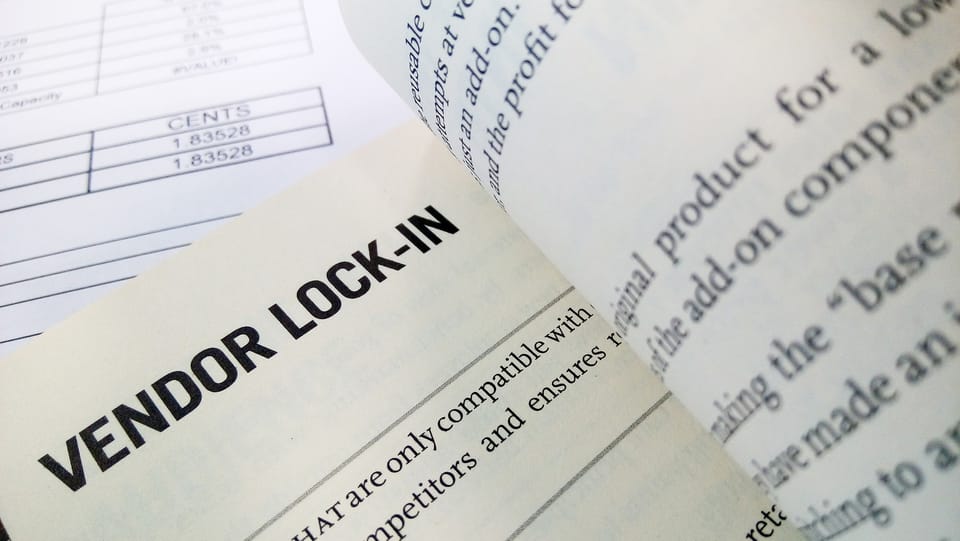The Singapore SME’s Guide to a Vendor‑Agnostic IT Strategy

The Lock‑in Squeeze
Your SME has grown steadily for years on a tidy single‑vendor stack. Now the renewal lands: a forced “bundle upgrade,” steep price hike, multi‑year term, and proprietary migration fees if you say no. Compliance is tightening, staff need remote access, and you want to experiment with AI and automation—without rebuilding the house. The problem isn’t just cost. It’s control. A vendor‑agnostic IT strategy helps you regain it.
What does “vendor‑agnostic” really mean?
Vendor‑agnostic IT means you design, procure, and operate technology so that no single supplier dictates your options, costs, or timelines. In practice, it covers:
Architecture: Choose standards‑based platforms and open, documented interfaces so components interoperate.
Procurement: Evaluate tools on fit and value, not on bundled kickbacks or “free” add‑ons that hide long‑term costs.
Lifecycle management: Keep exit paths open with data portability, reversible configurations, and contract terms that let you switch without disruption.
Governance: Separate solution selection from incentives so recommendations are objective and in your business’s best interest.
Why it matters to SMEs in Singapore
Control your total cost of ownership (TCO): By avoiding lock‑in, you can renegotiate, right‑size, or swap components as needs change—without wholesale rip‑and‑replace.
Flexibility as you evolve: Add or replace tools without replatforming the entire stack when you expand, shrink, or pivot to new business models.
Risk reduction: Diversify away from single points of failure across vendors, deployment models, and support channels.
Better alignment with local realities: Singapore SMEs often juggle tight budgets, data‑residency considerations, and industry‑specific regulations. A vendor‑agnostic posture lets you pick the right mix—cloud, on‑prem, or hybrid—per workload.

Cloud‑first or local deployment: how should an SME decide?
A cloud‑first approach typically wins on scalability, speed of deployment, and predictable OPEX—ideal for most modern workloads and SME IT strategy in Singapore. Still, there are legitimate reasons to choose or retain local/on‑prem deployments for specific systems. Use this simple decision checklist:
Choose cloud‑first when:
- You want to scale quickly without capital expenditure.
- Your workloads are standard productivity, collaboration, CRM, email, or modern analytics.
- You benefit from built‑in high availability and geographic redundancy.
- Your compliance needs are satisfied by major cloud providers’ certifications and controls.
- You prefer operational flexibility with pay‑as‑you‑go consumption.
Choose local/on‑prem when:
- A core application demands low, predictable latency on‑site (e.g., factory floor systems).
- Data residency or regulatory constraints require specific storage/processing conditions.
- You have specialized hardware needs or legacy systems not yet cloud‑compatible.
- You need deterministic performance in constrained network environments.
Hybrid best practice:
- Keep authoritative data in systems that support export in open formats.
- Use APIs or integration platforms for interoperability.
- Maintain clear runbooks for failover and restoration across cloud and on‑prem components.
How do you implement vendor‑agnostic IT without disruption?

- Assess your current stack and contracts
- Inventory all applications, integrations, data stores, and dependencies.
- Map contract terms, auto‑renewal dates, and termination clauses.
- Identify where proprietary formats, closed APIs, or hardware tie‑ins create lock‑in risk.
- Define standards and interoperability requirements
- Prefer open protocols (e.g., SAML/OIDC for identity, SMTP/IMAP for email, REST/GraphQL for APIs).
- Standardize identity and access management to avoid per‑application silos.
- Establish data portability requirements (export formats, retention, deletion).
- Build a procurement playbook
- Shortlist criteria: business fit, security posture, performance, TCO, interoperability, support quality.
- Run proof‑of‑concepts with realistic data and success metrics.
- Bake in exit clauses: data export, migration assistance, and capped termination fees.
- Avoid acceptance criteria that depend on a single vendor’s proprietary features.
- Set security and compliance guardrails
- Adopt a zero‑trust mindset: strong identity, least privilege, MFA, continuous monitoring.
- Align with PDPA obligations for data minimization, consent management, retention, and secure disposal.
- Require vendors to provide security documentation (encryption, key management, incident response SLAs).
- Plan your cost model and lifecycle
- Compare OPEX vs CAPEX and model 3–5 year TCO under different usage scenarios.
- Include change costs: training, migration, integrations, and potential exit costs.
- Schedule regular reviews to right‑size licenses, storage, and support plans.
- Manage change and enable people
- Communicate the “why” and the expected outcomes early.
- Provide role‑based training and quick reference guides.
- Phase rollouts to minimize disruption, with pilots and feedback loops.
What pitfalls should SMEs watch out for?

Hidden commissions and incentives: If recommendations are influenced by vendor kickbacks, you may not be getting objective advice. A fee‑only model avoids this structural conflict and supports unbiased decisions www.techease.com.sg.
“Free” bundles with strings attached: Bundled add‑ons can increase long‑term costs or restrict future choices; insist on transparent pricing and separable components.
Proprietary formats and closed APIs: If you can’t export data cleanly, you’re already locked in; verify portability before signing.
Vague SLAs and service boundaries: Clarify uptime, response times, escalation paths, and who owns what in multi‑vendor incidents.
Migration penalties: Understand data egress fees, conversion tools, and timelines; negotiate exit support upfront.
How Techease supports a vendor‑agnostic approach
Fee‑only, client‑first model
Techease does not rely on vendor commissions or push‑based hardware/software sales. This aligns incentives with your business goals and keeps recommendations objective www.techease.com.sg.
Vendor‑agnostic solution design
Hardware and software are selected based solely on your business case, helping lower TCO, reduce lock‑in risk, and increase flexibility as you grow www.techease.com.sg.
Cloud‑first with local/on‑prem options
Techease adopts cloud‑first for scalability and cost‑efficiency but will design, install, and manage local deployments when regulatory or application needs require it www.techease.com.sg.
Singapore‑based, service‑focused support
You get an agile local team for responsive, face‑to‑face service—valuable when you need hands‑on help beyond generic global support queues www.techease.com.sg.
Two‑week satisfaction guarantee
Start risk‑sensibly; if you’re not satisfied, you can cancel within the first two weeks for a no‑questions‑asked refund www.techease.com.sg.
Decision checklist you can use this quarter

- Identify 3 systems at highest risk of lock‑in (e.g., ERP, payroll, file storage).
- For each, confirm data export methods, formats, and any fees.
- Review contract terms for renewals and termination windows.
- Draft target standards (identity, integration, data formats) and test them in a small pilot.
- Run a 2–4 week proof‑of‑concept with an alternative vendor or deployment model.
- Document a minimal exit plan: how you would move, how long it would take, who is responsible.
Three quick wins for most SMEs
- Centralize identity and MFA: Move to a unified identity platform to reduce per‑app lock‑in and improve security.
- Standardize backups with off‑platform copies: Maintain at least one backup outside your primary vendor to preserve exit options.
- Normalize integrations via APIs: Replace brittle, vendor‑specific connectors with standards‑based API integrations or iPaaS tools.
FAQ
Q1: How can a vendor‑agnostic strategy help me avoid vendor lock‑in without increasing complexity?
A balanced approach doesn’t mean adding more tools. It means choosing ones that work with standards and can be swapped if needed. Use a small, interoperable core (identity, device management, storage, integration platform) and build from there. Complexity usually drops because you eliminate one‑off, proprietary workarounds and focus on documented interfaces.
Q2: Should I go cloud‑first or keep some systems on‑prem?
For most SMEs, cloud‑first wins on speed, resilience, and OPEX control. Keep or deploy on‑prem only where compliance, latency, or application constraints require it, and design clear integration points so you can change your mind later. This is the pragmatic middle path many Singapore SMEs follow to balance agility with regulatory needs.
Q3: How do I choose a vendor‑agnostic MSP in Singapore?
Look for fee‑only advisory (no commissions), transparent service‑based pricing, proof of vendor‑agnostic selection, and local, responsive support. Ask for data portability commitments, exit support, and a short satisfaction window so you can validate fit quickly. Techease meets these criteria with a fee‑only model, vendor‑agnostic selection, local service, and a two‑week satisfaction guarantee www.techease.com.sg.
If you want a practical, vendor‑agnostic roadmap tailored to your environment, book a complimentary consultation to assess lock‑in risks and identify quick wins. Click here to learn more about Techease’s fee‑only, vendor‑agnostic approach and local support.






